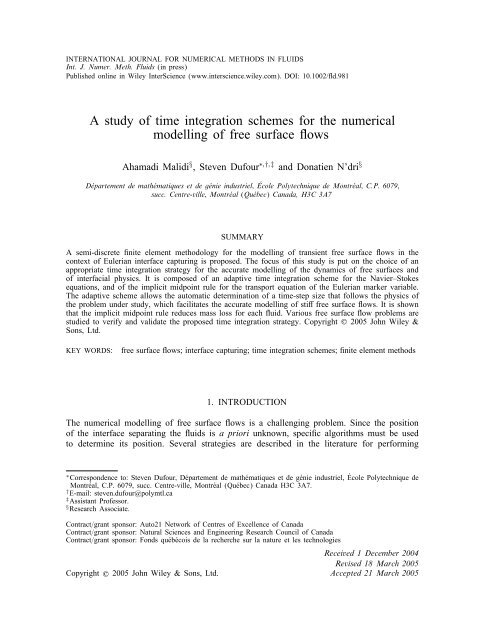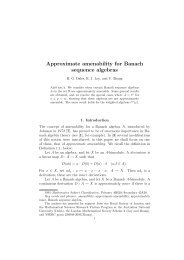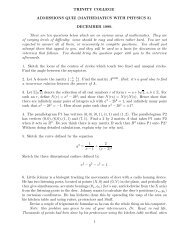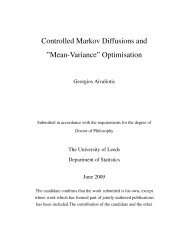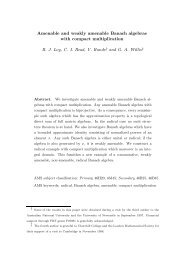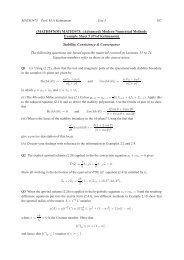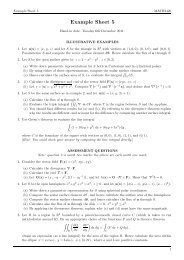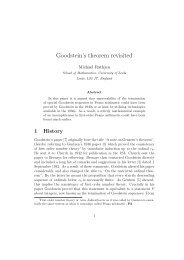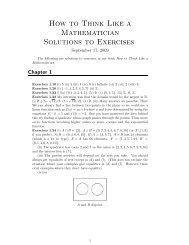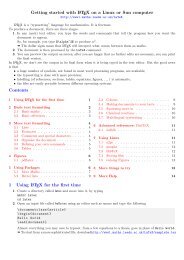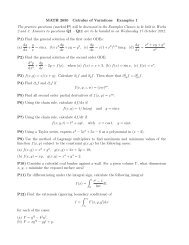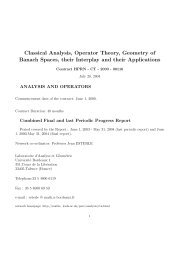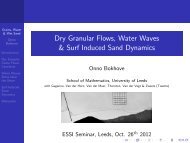A study of time integration schemes for the numerical modelling of ...
A study of time integration schemes for the numerical modelling of ...
A study of time integration schemes for the numerical modelling of ...
You also want an ePaper? Increase the reach of your titles
YUMPU automatically turns print PDFs into web optimized ePapers that Google loves.
INTERNATIONAL JOURNAL FOR NUMERICAL METHODS IN FLUIDSInt. J. Numer. Meth. Fluids (in press)Published online in Wiley InterScience (www.interscience.wiley.com). DOI: 10.1002/d.981A <strong>study</strong> <strong>of</strong> <strong>time</strong> <strong>integration</strong> <strong>schemes</strong> <strong>for</strong> <strong>the</strong> <strong>numerical</strong><strong>modelling</strong> <strong>of</strong> free surface owsAhamadi Malidi § , Steven Dufour ∗; †; ‡ and Donatien N’dri §Departement de ma<strong>the</strong>matiques et de genie industriel; Ecole Polytechnique de Montreal; C.P. 6079;succ. Centre-ville; Montreal (Quebec) Canada, H3C 3A7SUMMARYA semi-discrete nite element methodology <strong>for</strong> <strong>the</strong> <strong>modelling</strong> <strong>of</strong> transient free surface ows in <strong>the</strong>context <strong>of</strong> Eulerian interface capturing is proposed. The focus <strong>of</strong> this <strong>study</strong> is put on <strong>the</strong> choice <strong>of</strong> anappropriate <strong>time</strong> <strong>integration</strong> strategy <strong>for</strong> <strong>the</strong> accurate <strong>modelling</strong> <strong>of</strong> <strong>the</strong> dynamics <strong>of</strong> free surfaces and<strong>of</strong> interfacial physics. It is composed <strong>of</strong> an adaptive <strong>time</strong> <strong>integration</strong> scheme <strong>for</strong> <strong>the</strong> Navier–Stokesequations, and <strong>of</strong> <strong>the</strong> implicit midpoint rule <strong>for</strong> <strong>the</strong> transport equation <strong>of</strong> <strong>the</strong> Eulerian marker variable.The adaptive scheme allows <strong>the</strong> automatic determination <strong>of</strong> a <strong>time</strong>-step size that follows <strong>the</strong> physics <strong>of</strong><strong>the</strong> problem under <strong>study</strong>, which facilitates <strong>the</strong> accurate <strong>modelling</strong> <strong>of</strong> sti free surface ows. It is shownthat <strong>the</strong> implicit midpoint rule reduces mass loss <strong>for</strong> each uid. Various free surface ow problems arestudied to verify and validate <strong>the</strong> proposed <strong>time</strong> <strong>integration</strong> strategy. Copyright ? 2005 John Wiley &Sons, Ltd.KEY WORDS:free surface ows; interface capturing; <strong>time</strong> <strong>integration</strong> <strong>schemes</strong>; nite element methods1. INTRODUCTIONThe <strong>numerical</strong> <strong>modelling</strong> <strong>of</strong> free surface ows is a challenging problem. Since <strong>the</strong> position<strong>of</strong> <strong>the</strong> interface separating <strong>the</strong> uids is a priori unknown, specic algorithms must be usedto determine its position. Several strategies are described in <strong>the</strong> literature <strong>for</strong> per<strong>for</strong>ming∗ Correspondence to: Steven Dufour, Departement de ma<strong>the</strong>matiques et de genie industriel, Ecole Polytechnique deMontreal, C.P. 6079, succ. Centre-ville, Montreal (Quebec) Canada H3C 3A7.† E-mail: steven.dufour@polymtl.ca‡ Assistant Pr<strong>of</strong>essor.§ Research Associate.Contract=grant sponsor: Auto21 Network <strong>of</strong> Centres <strong>of</strong> Excellence <strong>of</strong> CanadaContract=grant sponsor: Natural Sciences and Engineering Research Council <strong>of</strong> CanadaContract=grant sponsor: Fonds quebecois de la recherche sur la nature et les technologiesReceived 1 December 2004Revised 18 March 2005Copyright ? 2005 John Wiley & Sons, Ltd. Accepted 21 March 2005
A. MALIDI, S. DUFOUR AND D. N’DRIcomputer simulations <strong>of</strong> multiuid ows [1]. In this <strong>study</strong>, we are particularly interested ina family <strong>of</strong> methods based on a marker variable that is used to identify <strong>the</strong> region occupiedby each uid. The zero thickness interface is traded <strong>for</strong> a transition zone <strong>of</strong> <strong>the</strong> marker.This variable is <strong>the</strong>n transported by <strong>the</strong> velocity eld <strong>of</strong> each uid, by solving a transportequation <strong>of</strong> <strong>the</strong> marker on a xed grid. This Eulerian approach, which is also known asfree surface capturing, is popular <strong>for</strong> <strong>modelling</strong> complex multiuid ows. Among <strong>the</strong> mostpopular free surface capturing methods we can mention <strong>the</strong> volume <strong>of</strong> uid method [2],<strong>the</strong> level set method [3], and <strong>the</strong> pseudo-concentration method [4], to name a few. Thisapproach is better suited <strong>for</strong> <strong>modelling</strong> <strong>the</strong> evolution <strong>of</strong> free surfaces submitted to largeand complex de<strong>for</strong>mations. Modelling multiple interface ows is not a complicated matter,since <strong>the</strong> interface is not treated as an explicit computational entity. Free surface splittingand reconnection are handled implicitly. However, this strategy is known to be lessaccurate if <strong>the</strong> <strong>numerical</strong> strategy is not well chosen. This is due to <strong>the</strong> uncertaintyinherent in <strong>the</strong> use <strong>of</strong> <strong>the</strong> region <strong>of</strong> transition <strong>of</strong> <strong>the</strong> marker variable to locate <strong>the</strong> free surface,which makes it impossible to impose interfacial boundary conditions explicitly. Freesurface capturing methods are also known to suer from <strong>numerical</strong> diusion or oscillations[5]. This results in <strong>the</strong> de<strong>for</strong>mation <strong>of</strong> <strong>the</strong> region <strong>of</strong> transition <strong>of</strong> <strong>the</strong> markervariable, and <strong>the</strong>re<strong>for</strong>e to mass-conservation problems and to an inaccurate <strong>modelling</strong> <strong>of</strong>interfacial physics. It is <strong>the</strong>re<strong>for</strong>e important to choose <strong>the</strong> right <strong>numerical</strong> strategy inorder to per<strong>for</strong>m an accurate transport <strong>of</strong> <strong>the</strong> free surfaces, and to conserve mass <strong>for</strong>each uid.Several components in a <strong>numerical</strong> methodology inuence <strong>the</strong> accuracy <strong>of</strong> a free surfacecapturing strategy. An inaccurate discretization may lead to an imbalance between <strong>the</strong> viscous<strong>for</strong>ces and <strong>the</strong> capillary <strong>for</strong>ces, which will translate into <strong>numerical</strong> instabilities [6]. It is wellknown that a ‘good’ mesh will provide an accurate discretization <strong>of</strong> <strong>the</strong> variables <strong>of</strong> <strong>the</strong>problem [6]. We also observe that <strong>the</strong> elliptic solvers introduce non-physical oscillations ordiusion when <strong>the</strong> solution <strong>of</strong> a partial dierential equation contains a discontinuity or anabrupt variation [7]. Finally, <strong>the</strong> choice <strong>of</strong> an appropriate <strong>time</strong> <strong>integration</strong> scheme, to discretize<strong>the</strong> transient term <strong>of</strong> <strong>the</strong> equations, is important to help conserve mass <strong>for</strong> each uid. To ourknowledge, we do not know <strong>of</strong> a <strong>study</strong> relating <strong>the</strong> discretization in <strong>time</strong> to mass-conservationproblems and interfacial instabilities when <strong>modelling</strong> free surface ows using an Eulerianapproach.Authors <strong>study</strong>ing multiuid ows use various <strong>time</strong> <strong>integration</strong> <strong>schemes</strong>. Examples are: <strong>the</strong>backward Euler scheme <strong>for</strong> mold lling problems [8]; <strong>the</strong> trapezoid rule (TR) <strong>for</strong> sloshingproblems [9]; and <strong>the</strong> backward dierentiation <strong>for</strong>mula (BDF) (Gear scheme) <strong>for</strong> dropsdynamics problems [10] to name a few. But <strong>the</strong>se studies do not mention <strong>the</strong> reasons <strong>for</strong><strong>the</strong>se choices. We are proposing to discuss various strategies <strong>for</strong> <strong>the</strong> discretization <strong>of</strong> <strong>the</strong>transient term <strong>of</strong> <strong>the</strong> partial dierential equations involved in <strong>the</strong> <strong>modelling</strong> <strong>of</strong> free surfaceows in an Eulerian context.After introducing <strong>the</strong> semi-discrete nite element methodology used <strong>for</strong> <strong>modelling</strong> free surfaceows using interface capturing, we rst look at <strong>the</strong> <strong>time</strong> discretization <strong>of</strong> <strong>the</strong>Navier–Stokes equations, which is important <strong>for</strong> <strong>modelling</strong> sti free surface ow problems.We <strong>the</strong>n <strong>study</strong> <strong>the</strong> inuence <strong>of</strong> <strong>the</strong> discretization <strong>of</strong> <strong>the</strong> transient term <strong>of</strong> <strong>the</strong> transport equationon mass conservation. We nally propose an overall <strong>time</strong> <strong>integration</strong> strategy <strong>for</strong> <strong>study</strong>ingfree surface ows. Various free surface ow problems are studied to verify and validate <strong>the</strong>proposed <strong>numerical</strong> strategy.Copyright ? 2005 John Wiley & Sons, Ltd.Int. J. Numer. Meth. Fluids (in press)
A STUDY OF TIME INTEGRATION SCHEMES FOR MODELLING FREE SURFACE FLOWS2. MODELLING OF THE PROBLEMConsider <strong>the</strong> free surface ow problem illustrated in Figure 1. The region occupied by <strong>the</strong>rst uid is denoted 1 . The second uid occupies <strong>the</strong> region 2 , and since <strong>the</strong> uids areimmiscible, 1 ∩ 2 = ∅. The computational domain can <strong>the</strong>re<strong>for</strong>e be dened as = 1 ∪ 2 .The interface separating <strong>the</strong> two uids is denoted by S. The unit normal to <strong>the</strong> interface isdenoted n S .The ow <strong>of</strong> each uid is modelled using <strong>the</strong> equations expressing conservation <strong>of</strong> massand momentum. There<strong>for</strong>e, <strong>the</strong> equationsand∇ · u = 0 (1) @u + (u · ∇)u = ∇ · (2)@tmust be solved <strong>for</strong> uids 1 and 2, i.e. on 1 and 2 , respectively, where =−pI + is <strong>the</strong> Cauchy stress tensor, and <strong>the</strong> density <strong>of</strong> <strong>the</strong> uid is denoted . The extra-stress tensor is related to <strong>the</strong> velocity eld by <strong>the</strong> relation =2˙(u)where is <strong>the</strong> viscosity <strong>of</strong> <strong>the</strong> uid, and <strong>the</strong> rate-<strong>of</strong>-strain tensor ˙ is dened by˙(u)= 1 2 (∇u +(∇u)T )The dependent variables <strong>of</strong> <strong>the</strong> problem will <strong>the</strong>re<strong>for</strong>e be denoted u 1 and u 2 <strong>for</strong> <strong>the</strong> velocityeld <strong>of</strong> uids 1 and 2, and <strong>the</strong> pressure <strong>of</strong> <strong>the</strong> uids will be denoted p 1 and p 2 .Boundary conditions can ei<strong>the</strong>r be <strong>of</strong> <strong>the</strong> essential type (Dirichlet boundary conditions):u i = u @ or <strong>of</strong> <strong>the</strong> natural type (Neumann boundary conditions): i · n = t @ , where i =1; 2inour case. The conditions at <strong>the</strong> interface S are [1]: <strong>the</strong> continuity <strong>of</strong> normal velocitiesu 1 · n S = u 2 · n S = u S · n Su 2nΩ 1Ω 2Figure 1. A free surface ow problem.Copyright ? 2005 John Wiley & Sons, Ltd.Int. J. Numer. Meth. Fluids (in press)
A STUDY OF TIME INTEGRATION SCHEMES FOR MODELLING FREE SURFACE FLOWSis used to discretize <strong>the</strong> transport equation (3). A quadratic element is used to discretize <strong>the</strong>pseudo-concentration. The stabilization parameter is given by h=2‖u‖, where h is <strong>the</strong> localmesh size.The continuum surface <strong>for</strong>ce model [12] is used to include <strong>the</strong> inuence <strong>of</strong> surface tensionin <strong>the</strong> <strong>numerical</strong> model. Surface tension is considered as a volume <strong>for</strong>ce dened in <strong>the</strong> smoothregion <strong>of</strong> transition <strong>of</strong> <strong>the</strong> Eulerian marker variable. Formally, <strong>the</strong> surface capillary <strong>for</strong>cef S = n S S is written as a volume <strong>for</strong>ce f V = (F)∇F, dened in <strong>the</strong> region <strong>of</strong> transition<strong>of</strong> F. The Dirac delta function S , dened on <strong>the</strong> interface S, is approximated <strong>numerical</strong>lyin <strong>the</strong> region <strong>of</strong> transition <strong>of</strong> F using ‖∇F‖, and <strong>the</strong> curvature is approximated using( ) ∇F =−∇ · n S ≈−∇ ·‖∇F‖The capillary <strong>for</strong>ce f V is included in <strong>the</strong> Navier–Stokes equations (2) to yield @u@t + (u · ∇)u = ∇ · + f V (5)4. TIME INTEGRATION SCHEMES FOR THE NAVIER–STOKES EQUATIONS4.1. Motivation: Laplace’s problemAn accurate discretization <strong>of</strong> <strong>the</strong> velocity eld <strong>of</strong> <strong>the</strong> uids is important <strong>for</strong> an accurate advection<strong>of</strong> <strong>the</strong> pseudo-concentration (cf. Equation (3)). A well-known free surface ow problem,<strong>for</strong> which an inaccurate discretization <strong>of</strong> <strong>the</strong> transient term <strong>of</strong> <strong>the</strong> Navier–Stokes equations canbe problematic, is Laplace’s problem. The problem consists <strong>of</strong> a ‘two-dimensional’ drop <strong>of</strong>uid <strong>of</strong> an arbitrary shape, an ellipse <strong>for</strong> example, in ano<strong>the</strong>r uid at rest. The capillary <strong>for</strong>cebetween <strong>the</strong> two uids induces a ow which makes <strong>the</strong> drop reach a topology that minimizesenergy, i.e. a circle in two dimensions. The curvature <strong>of</strong> <strong>the</strong> steady-state drop and <strong>the</strong> jumpin pressure should verify Laplace’s law,p 1 − p 2 = (6)This problem is popular <strong>for</strong> verifying <strong>numerical</strong> surface tension models in simulation codes.Despite its simplicity, Laplace’s problem is <strong>numerical</strong>ly challenging. It is well documentedin References [13–18] that if <strong>the</strong> <strong>numerical</strong> strategy is not well chosen, <strong>numerical</strong>lyinduced parasitic currents will appear in <strong>the</strong> vicinity <strong>of</strong> <strong>the</strong> free surface when ‖u‖ →0 (cf.Figure 2(a)). This leads to an inaccurate discretization <strong>of</strong> <strong>the</strong> jump in pressure at <strong>the</strong> freesurface (cf. Figure 2(b)), and eventually to a ow that does not reach a steady-state. Severalhypo<strong>the</strong>ses are brought <strong>for</strong>ward in <strong>the</strong> literature in order to explain this phenomenon and tond a cure.Ko<strong>the</strong> et al. [14] convolve <strong>the</strong> marker variable F with various smooth kernels to obtaina mollied colour function ˜F. This leads to a more accurate computation <strong>of</strong> <strong>the</strong> unit normalto <strong>the</strong> free surface n S and <strong>of</strong> <strong>the</strong> curvature , which in turn reduces parasitic currents. O<strong>the</strong>rauthors have improved <strong>the</strong> <strong>numerical</strong> discretization <strong>the</strong>y were using in order to obtain a moreaccurate <strong>modelling</strong> <strong>of</strong> interfacial physics. This is <strong>the</strong> case <strong>of</strong> Popinet and Zaleski [15] whouse higher accuracy discretizations <strong>of</strong> <strong>the</strong> Lagrangian representation <strong>of</strong> <strong>the</strong> free surface, and<strong>of</strong> <strong>the</strong> pressure, which leads to a reduction <strong>of</strong> parasitic currents. In a similar fashion, <strong>the</strong>Copyright ? 2005 John Wiley & Sons, Ltd.Int. J. Numer. Meth. Fluids (in press)
A. MALIDI, S. DUFOUR AND D. N’DRIFigure 2. Numerical instabilities in <strong>modelling</strong> Laplace’s problem: (a) parasiticcurrents; and (b) pressure contours.PROST algorithm [17] was also devised to eliminate <strong>the</strong> spurious currents problem. In thisalgorithm, free surface capturing is per<strong>for</strong>med with <strong>the</strong> VOF (volume <strong>of</strong> uid) technique, usinga least square t <strong>of</strong> a quadratic surface to <strong>the</strong> colour function <strong>for</strong> each interface cell and itsneighbours. The authors also implemented a higher-order advection scheme <strong>for</strong> <strong>the</strong> transportequation <strong>of</strong> <strong>the</strong> colour function. Hou et al. [19] ra<strong>the</strong>r consider Laplace’s problem as a stiproblem. They devised a <strong>numerical</strong> procedure based on <strong>the</strong> boundary integral <strong>for</strong>mulation toremove <strong>the</strong> stiness due to surface tension. The <strong>numerical</strong> results found in <strong>the</strong>se referencesshow that parasitic currents are in fact reduced, but it is not clear if <strong>the</strong> steady-state is reached.We have found that several aspects <strong>of</strong> <strong>the</strong>se studies are important [20]. In particular, <strong>the</strong>fact that this problem is sti is <strong>of</strong>ten overlooked, and we think, like Hou et al. [19], that this is<strong>the</strong> key to <strong>the</strong> accurate <strong>modelling</strong> <strong>of</strong> Laplace’s problem. This led us to develop a methodologyto tackle sti free surface ow problems through <strong>the</strong> use <strong>of</strong> a <strong>time</strong> <strong>integration</strong> strategy whichincludes an adaptive scheme <strong>for</strong> <strong>the</strong> transient term <strong>of</strong> <strong>the</strong> Navier–Stokes equations. Thisstrategy will allow us to modify <strong>the</strong> size <strong>of</strong> <strong>the</strong> <strong>time</strong> discretization in order to maintain <strong>the</strong>balance between <strong>the</strong> viscous <strong>for</strong>ces and <strong>the</strong> capillary <strong>for</strong>ces when approaching steady-state.Our hypo<strong>the</strong>sis is that such a scheme will allow us to reach <strong>the</strong> steady-state <strong>of</strong> Laplace’sproblem with no parasitic currents at <strong>the</strong> free surface.4.2. Adaptive <strong>time</strong> <strong>integration</strong> schemeAdaptive <strong>time</strong> <strong>integration</strong> <strong>schemes</strong> <strong>for</strong> <strong>the</strong> Navier–Stokes equations are not new in <strong>the</strong>computational science literature (cf. Reference [21] <strong>for</strong> details). They allow <strong>the</strong> automaticcomputation <strong>of</strong> an ‘optimal’ <strong>time</strong>-step size t n at every <strong>time</strong> step, in order to adapt <strong>the</strong> <strong>time</strong>discretization to follow <strong>the</strong> physics <strong>of</strong> <strong>the</strong> modelled problem. This strategy is a common practice<strong>for</strong> discretizing spatial variables. It is dicult to explain why it is not more popular in<strong>the</strong> CFD literature <strong>for</strong> <strong>the</strong> temporal variable. It is particularly absent from <strong>the</strong> free surfaceow <strong>modelling</strong> literature.The most popular adaptive <strong>time</strong> <strong>integration</strong> scheme is <strong>the</strong> adaptive trapezoid rule (ATR).Even if this scheme is devised to compute <strong>the</strong> appropriate <strong>time</strong>-step size in order to avoid<strong>the</strong> oscillations <strong>of</strong>ten seen with <strong>the</strong> standard TR, <strong>the</strong> ATR scheme can still exhibit wigglesCopyright ? 2005 John Wiley & Sons, Ltd.Int. J. Numer. Meth. Fluids (in press)
A STUDY OF TIME INTEGRATION SCHEMES FOR MODELLING FREE SURFACE FLOWSin some cases [21]. This is why we choose to use an adaptive backward dierentiation<strong>for</strong>mulae (ABDF), which is based on <strong>the</strong> constant-<strong>time</strong>-step size second-order accurate BDF,also known as Gear scheme. This choice is justied by <strong>the</strong> fact that <strong>the</strong> BDF scheme isknown to damp oscillatory solutions.The nite element discretization <strong>of</strong> velocity and pressure,∑u(x)= 7 ∑u i ’ i (x) and p(x)= 3 p i i (x)i=1where ’ i (x) and i (x) are <strong>the</strong> nite element interpolation functions <strong>of</strong> <strong>the</strong> Crouzeix–Raviartelement and <strong>the</strong> u i and <strong>the</strong> p i are <strong>the</strong> degrees <strong>of</strong> freedom <strong>of</strong> velocity and pressure on anelement, are introduced in <strong>the</strong> elementary linearized weak <strong>for</strong>ms <strong>of</strong> <strong>the</strong> conservation <strong>of</strong> mass(1) and momentum (2) equations, to yield an algebraic system <strong>of</strong> equations <strong>of</strong> <strong>the</strong> <strong>for</strong>m (seeReference [22] <strong>for</strong> details)[ ] ⎡ ⎤M 0˙ [Ũ A BT] ⎡ ⎤ ⎡ ⎤Ũ ˜F⎣ ⎦ + ⎣ ⎦ = ⎣ ⎦0 0 ˜P˙ B 0 ˜P ˜0The vector Ũ contains <strong>the</strong> degrees <strong>of</strong> freedom in velocity, ˜P contains <strong>the</strong> degrees <strong>of</strong> freedomin pressure, M is <strong>the</strong> mass matrix <strong>of</strong> <strong>the</strong> transient term, A is <strong>the</strong> viscous term matrix andB is <strong>the</strong> discrete divergence matrix. But since we are using Uzawa’s algorithm to en<strong>for</strong>ce<strong>the</strong> incompressibility constraint, as described in Section 3, this linear system <strong>of</strong> equationsreduces toMŨ ˙ + A r Ũ = F r (7)(cf. Reference [11] <strong>for</strong> details). We <strong>the</strong>re<strong>for</strong>e per<strong>for</strong>m transient error control only on <strong>the</strong>degrees <strong>of</strong> freedom in velocity. The degrees <strong>of</strong> freedom in pressure will be updated byUzawa’s algorithm.Following <strong>the</strong> development <strong>of</strong> Gresho et al. [21], we implemented an ABDF scheme <strong>for</strong><strong>the</strong> discretization <strong>of</strong> <strong>the</strong> Navier–Stokes equations. Based on <strong>the</strong> second-order accurate BDF,<strong>the</strong> variable-<strong>time</strong>-step size BDF scheme can be expressed asŨ˙n+1 = (2+(t n−1=t n ))Ũ n+1 − (2+(t n−1 =t n )+(t n =t n−1 ))Ũ n +(t n =t n−1 )Ũ n−1(8)t n +t n−1Using Taylor’s expansions:::ũ(t n±1 )=ũ(t n ± t n ) ≈ Ũ n±1 = Ũ n ± t ˙nŨn + 1 2 t2 nŨ n ± 1 6 t3 n Ũ n +O(tn) 4 (9)in (8), we nd <strong>the</strong> local truncation error <strong>of</strong> this variable-<strong>time</strong>-step size BDF scheme to beŨ n+1 − ũ(t n+1 )= (t n +t n−1 ) 2t n (2t n +t n−1 )t 3 n6:::Ũ ni=1+ O(t 4 ) (10)In order to be able to determine <strong>the</strong> next <strong>time</strong>-step size t n+1 , we need to express <strong>the</strong> localtruncation error <strong>of</strong> <strong>the</strong> ABDF scheme in term <strong>of</strong> Ũ n+1 . We rst need some kind <strong>of</strong> ‘cheap’Copyright ? 2005 John Wiley & Sons, Ltd.Int. J. Numer. Meth. Fluids (in press)
A. MALIDI, S. DUFOUR AND D. N’DRI:::predictor scheme with a local truncation error which is also in tn3 Ũ n . The variable-<strong>time</strong>-stepsize explicit midpoint rule is such a candidate:(Ũ p n+1 = Ũ n + 1+ t ) ( ) 2nt ˙ tnnŨn − (Ũ n − Ũ n−1 ) (11)t n−1 t n−1with a local truncation error <strong>of</strong>Ũ p n+1 − ũ(t n+1)=−:::(1+ t )n t3nt n−1 6Ũ n+ O(t 4 ) (12)which can again be obtained by using (9) in (11).We can now express <strong>the</strong> local truncation error <strong>of</strong> <strong>the</strong> ABDF scheme in terms <strong>of</strong> only Ũ n+1 ,Ũ p n+1 and t n. Subtracting Equation (12) from Equation (10), we obtainwhich can be written as:::[Ũ n+1 − Ũ p n+1 ≈ (tn +t n−1 ) 2 (t n (2t n +t n−1 ) + 1+ t )]n t3nt n−1 6t 3 n6:::Ũ nin order to rewrite expression (10) as≈ (Ũ n+1 − Ũ p n+1 ) /[ (tn +t n−1 ) 2t n (2t n +t n−1 ) + (1+ t nt n−1)]Ũ n+1 − ũ(t n+1 ) ≈ (t n+t n−1 ) 2 {/[(Ũ n+1 −Ũ p n+1t n (2t n +t n−1 )) (tn +t n−1 ) 2t n (2t n +t n−1 ) + t ]}n+1t n−1After simplifying this expression, we can express <strong>the</strong> local truncation error <strong>of</strong> <strong>the</strong> ABDFscheme, which will now be denoted ˜d n ,asŨ n˜d n = (1+(t n−1=t n ))(Ũ n+1 − Ũ p n+1 )2+(t n−1 =t n ) + 2(t n =t n−1 )(13)The new <strong>time</strong>-step size is <strong>the</strong>n obtained by rst observing that <strong>the</strong> local truncation error(10) <strong>of</strong> (8) gives us:˜d n+1= Ũn+2 − ũ(t n+2 )˜d nU n+1 − ũ(t n+1 ) ≈ t3 n+1:::Ũ n+1:::tn3 Ũ n( ) 3 tn+1≈(14)t nSince we want to control <strong>the</strong> size <strong>of</strong> <strong>the</strong> local truncation error at <strong>the</strong> next <strong>time</strong> step, i.e.‖˜d n+1 ‖¡ (15)Copyright ? 2005 John Wiley & Sons, Ltd.Int. J. Numer. Meth. Fluids (in press)
A STUDY OF TIME INTEGRATION SCHEMES FOR MODELLING FREE SURFACE FLOWS1.5Time History <strong>for</strong> <strong>the</strong> Von Karman ProblemTime-Step Sizes10.500 50 100 150TimeFigure 5. Time-step sizes computed by <strong>the</strong> ABDF scheme <strong>for</strong> <strong>the</strong> Von Karman problem. =5:80. The wavelength <strong>of</strong> <strong>the</strong>ir simulations was =5:32. Based on our results, we nd <strong>the</strong>same period and wavelength.Finally, Figure 6 illustrates plots <strong>of</strong> various quantities at t = t ref , in order to compare qualitativelyour results with <strong>the</strong> ones <strong>of</strong> Engelman and Jamnia. We can again see that our guresare very similar to <strong>the</strong> ones <strong>of</strong> <strong>the</strong> benchmark paper.4.4. Laplace’s problem revisitedLaplace’s problem will now be studied using <strong>the</strong> ABDF <strong>time</strong> <strong>integration</strong> scheme <strong>for</strong> <strong>the</strong>Navier–Stokes equations. The discretization <strong>of</strong> <strong>the</strong> transient term <strong>of</strong> <strong>the</strong> transport equation (3),which is not a problem in this case, will be discussed in <strong>the</strong> next section.Let us consider a ‘2-D’ drop <strong>of</strong> uid <strong>of</strong> area 4 in a geometry with dimensions [−3; 3] ×[−3; 3]. As an example, <strong>the</strong> initial drop can have <strong>the</strong> shape <strong>of</strong> an ellipse described byy = ±B √ 1 − (x 2 =L 2 ), such that LB = 4, where L and B are <strong>the</strong> longest and shortest semiaxes<strong>of</strong> <strong>the</strong> ellipse. The uids are initially at rest, with same density and viscosity. Let ussuppose that <strong>the</strong> surface tension coecient between <strong>the</strong> uids is =2. If L ≠ B, <strong>the</strong> capillary<strong>for</strong>ce will generate a ow which will de<strong>for</strong>m <strong>the</strong> drop until it reaches <strong>the</strong> shape <strong>of</strong> a circle <strong>of</strong>radius 2 in this case. According to Laplace’s law (6), we should observe a jump in pressure<strong>of</strong> p 1 − p 2 =1.Using <strong>the</strong> methodology described in Section 3 with <strong>the</strong> ABDF scheme, and with a structuredmesh containing 140 × 140 elements, <strong>the</strong> <strong>numerical</strong> <strong>modelling</strong> <strong>of</strong> Laplace’s problem gives us<strong>the</strong> <strong>time</strong>-step sizes illustrated in Figure 7. We observe a behaviour similar to <strong>the</strong> one illustratedin Figure 5 <strong>for</strong> <strong>the</strong> Von Karman problem, i.e. larger <strong>time</strong>-step sizes during <strong>the</strong> transient phase<strong>of</strong> <strong>the</strong> simulation, and smaller <strong>time</strong>-step sizes when <strong>the</strong> drop is reaching its steady-state shape.We, however, do not have <strong>the</strong> apparent ‘noise’ observed be<strong>for</strong>e, but we still observe smallCopyright ? 2005 John Wiley & Sons, Ltd.Int. J. Numer. Meth. Fluids (in press)
A. MALIDI, S. DUFOUR AND D. N’DRIFigure 6. Plots at t = t ref <strong>for</strong> <strong>the</strong> Von Karman vortex street problem: (a) horizontal velocity component;(b) vertical velocity component; and (c) pressure.variations <strong>of</strong> t n . This can be explained by <strong>the</strong> fact that when <strong>the</strong> drop reaches its steadystateshape, we still observe very small de<strong>for</strong>mations <strong>of</strong> <strong>the</strong> free surface that are captured by<strong>the</strong> transient error estimator. Figure 8 illustrates <strong>the</strong> <strong>time</strong> evolution <strong>of</strong> <strong>the</strong> jump in pressure.The fact that (p 1 − p 2 ) → 1 is an indication that <strong>the</strong> steady-state is reached. Streamlines arealso useful to determine if <strong>the</strong> steady-state <strong>of</strong> a free surface ow is reached. It can be seenin Figure 9(a) that <strong>the</strong> streamlines do not cross <strong>the</strong> free surface, which is ano<strong>the</strong>r goodindication that <strong>the</strong> <strong>numerical</strong> strategy allows us to reach <strong>the</strong> steady-state <strong>of</strong> this problem, withno parasitic currents. Ano<strong>the</strong>r indication that <strong>the</strong> surface tension-driven ow simulation isper<strong>for</strong>med accurately is <strong>the</strong> smooth transition <strong>of</strong> pressure, with no irregularities, as illustratedin Figure 9(b).Copyright ? 2005 John Wiley & Sons, Ltd.Int. J. Numer. Meth. Fluids (in press)
A STUDY OF TIME INTEGRATION SCHEMES FOR MODELLING FREE SURFACE FLOWS0.16 Laplace’s Problem0.140.12Time-Step Sizes0.10.080.060.040.0200 50 100 150 200 250 300Time StepsFigure 7. Time-step sizes computed by <strong>the</strong> ABDF scheme <strong>for</strong> Laplace’s problem.Laplace’s Problemreference∆ p1Pressure Jump00 100 200 300 400Time StepsFigure 8. Time evolution <strong>of</strong> <strong>the</strong> jump in pressure <strong>for</strong> Laplace’s problem.Copyright ? 2005 John Wiley & Sons, Ltd.Int. J. Numer. Meth. Fluids (in press)
A. MALIDI, S. DUFOUR AND D. N’DRI(a)(b)Figure 9. Steady-state <strong>of</strong> Laplace’s problem: (a) streamlines; and (b) pressure contours.5. TIME INTEGRATION SCHEMES FOR THE TRANSPORT EQUATION5.1. Motivation: <strong>the</strong> drop advection problemThe choice <strong>of</strong> an appropriate <strong>time</strong> <strong>integration</strong> scheme <strong>for</strong> <strong>the</strong> transport equation (3) is importantin our <strong>numerical</strong> methodology, since it directly inuences mass conservation. This can beillustrated with <strong>the</strong> drop advection problem (cf. Figure 10). A ‘2-D drop’, initially at rest, liesin ano<strong>the</strong>r uid which is submitted to <strong>the</strong> ow described by u(x;t)=(1; 0). It is well knownthat <strong>the</strong> advection <strong>of</strong> <strong>the</strong> marker variable, which represents <strong>the</strong> initial shape <strong>of</strong> <strong>the</strong> drop, willloose its initial shape, since it is subject to <strong>numerical</strong> oscillations or diusion. This is caused,among o<strong>the</strong>r reasons, by <strong>the</strong> <strong>time</strong> <strong>integration</strong> scheme used to discretize <strong>the</strong> transient term <strong>of</strong><strong>the</strong> transport equation (3).5.2. Numerical comparisonLet us consider three popular implicit, second-order accurate, A-stable <strong>time</strong> <strong>integration</strong><strong>schemes</strong> applied to <strong>the</strong> transport equation (3): <strong>the</strong> TR, also known as <strong>the</strong> Crank–Nicholsonscheme:F n+1 − F n+ 1 t 2 (un · ∇F n + u n+1 · ∇F n+1 )=0<strong>the</strong> BDF, also known as Gear scheme3F n+1 − 4F n + F n−1+ u n+1 · ∇F n+1 =02tand <strong>the</strong> implicit midpoint rule (IMR)F n+(1=2) − F n(t=2)+ u n+(1=2) · ∇F n+(1=2) =0; and F n+1 =2F n+(1=2) − F nWe could also mention <strong>the</strong> rst-order accurate backward Euler scheme:F n+1 − F n+ u n+1 · ∇F n+1 =0tCopyright ? 2005 John Wiley & Sons, Ltd.Int. J. Numer. Meth. Fluids (in press)
A STUDY OF TIME INTEGRATION SCHEMES FOR MODELLING FREE SURFACE FLOWSFigure 10. Drop advection problem.Drop Advection Problem3.73Drop Area3.72referenceTRBDFIMR0 50 100 150 200 250 300 350 400Time StepsFigure 11. Mass loss induced by <strong>time</strong> <strong>integration</strong> <strong>schemes</strong>.which is still popular in <strong>the</strong> computational science literature. It will not be included in our<strong>study</strong>. The comparison that will be per<strong>for</strong>med consists in measuring <strong>the</strong> mass (<strong>the</strong> area in2-D) <strong>of</strong> <strong>the</strong> drop <strong>for</strong> a given number <strong>of</strong> <strong>time</strong> steps. The <strong>numerical</strong> procedure <strong>for</strong> computing<strong>the</strong> mass <strong>of</strong> <strong>the</strong> drop is explained in <strong>the</strong> Appendix.Figure 11 illustrates <strong>the</strong> per<strong>for</strong>mance <strong>of</strong> <strong>the</strong> TR, BDF and IMR <strong>schemes</strong> with respect tomass conservation. It may seem surprising that TR, which is one <strong>of</strong> <strong>the</strong> most popular <strong>time</strong><strong>integration</strong> scheme used in CFD codes, per<strong>for</strong>ms poorly in our test. On <strong>the</strong> o<strong>the</strong>r hand, <strong>the</strong>IMR scheme which is not seen in many CFD papers, gives impressive results with respect tomass conservation. Quantitatively, we can observe, after only 400 non-dimensional <strong>time</strong> steps,<strong>for</strong> a xed <strong>time</strong>-step size <strong>of</strong> t =0:01 and <strong>for</strong> a mesh grid size x <strong>of</strong> <strong>the</strong> order <strong>of</strong> 0.07, amass loss <strong>of</strong> <strong>the</strong> order <strong>of</strong> 0.36% <strong>for</strong> TR while we have a mass loss <strong>of</strong> 0.001% <strong>for</strong> IMR.Copyright ? 2005 John Wiley & Sons, Ltd.Int. J. Numer. Meth. Fluids (in press)
A. MALIDI, S. DUFOUR AND D. N’DRIThis can be explained by <strong>the</strong> various properties <strong>of</strong> <strong>the</strong> IMR scheme [21]. This scheme issecond-order accurate, it introduces nearly no articial <strong>numerical</strong> oscillations, and it is A-stable, yet it introduces little undesirable damping compared to o<strong>the</strong>r A-stable <strong>schemes</strong>, whichmakes this scheme interesting <strong>for</strong> an advection equation. Constant-<strong>time</strong>-step size <strong>schemes</strong> areknown to give accurate results <strong>for</strong> a transport equation. Adaptive <strong>time</strong> <strong>integration</strong> <strong>schemes</strong>are suitable when <strong>the</strong> diusion term is non-negligible.6. OVERALL TIME INTEGRATION STRATEGY6.1. The <strong>time</strong> <strong>integration</strong> strategyBased on <strong>the</strong> results <strong>of</strong> <strong>the</strong> previous sections, <strong>the</strong> overall <strong>time</strong> <strong>integration</strong> strategy we propose<strong>for</strong> <strong>modelling</strong> free surface ows using an Eulerian free surface capturing approach is composed<strong>of</strong> <strong>the</strong> ABDF scheme <strong>for</strong> <strong>the</strong> Navier–Stokes equations coupled with <strong>the</strong> IMR scheme <strong>for</strong> <strong>the</strong>transport equation. Since we solve <strong>the</strong> system <strong>of</strong> partial dierential equations (2) and (3) ina coupled manner, <strong>the</strong> <strong>time</strong> steps used with <strong>the</strong> IMR scheme are <strong>the</strong> ones computed by <strong>the</strong>ABDF scheme.This strategy allows us to combine <strong>the</strong> previously described properties <strong>of</strong> both <strong>schemes</strong>,and to avoid <strong>the</strong>ir drawbacks. The BDF scheme <strong>for</strong> <strong>the</strong> transport equation is too diusive,which would lead to <strong>the</strong> de<strong>for</strong>mation <strong>of</strong> <strong>the</strong> pseudo-concentration and to mass loss. Moreover,an adaptive <strong>time</strong> <strong>integration</strong> scheme is not useful <strong>for</strong> an hyperbolic equation. In practice, weobserve that <strong>the</strong> <strong>time</strong>-step size reaches a constant value which corresponds to <strong>the</strong> chosentolerance, and it does not vary <strong>the</strong>reafter. The IMR scheme <strong>for</strong> <strong>the</strong> Navier–Stokes equationscould lead to <strong>numerical</strong> oscillations in <strong>the</strong> discretization <strong>of</strong> <strong>the</strong> velocity components.The proposed methodology is used to solve free surface ow problems <strong>of</strong> various nature in<strong>the</strong> following subsections. First, we will model Taylor’s problem using <strong>the</strong> proposed methodology.This problem is known to reach a steady-state <strong>for</strong> specic operating conditions. TheABDF scheme should smoothly handle this problem. We will <strong>the</strong>n <strong>study</strong> transient bubbleinteraction problems, which should be modelled accurately, with little mass loss, with <strong>the</strong>help <strong>of</strong> <strong>the</strong> IMR scheme.6.2. Numerical validation: Taylor’s problemLet us consider an initially unde<strong>for</strong>med ‘2-D circular drop’ <strong>of</strong> radius a = 1, located at <strong>the</strong>centre <strong>of</strong> a computational domain <strong>of</strong> dimensions [−5; 5] × [−5; 5]. The mesh grid size <strong>for</strong> thissimulation is x =0:2. We are interested in <strong>the</strong> steady-state shape reached by <strong>the</strong> drop whensubmitted to a Cartesian linear ow. The far eld ow is described byu(x)= 1 ( )1+ 1 − x2 ˙ (17)−1+ −1 − )(ywhere ˙ is <strong>the</strong> shear rate <strong>of</strong> <strong>the</strong> ow and is a ow-type parameter. For example, <strong>the</strong> case = 1 corresponds to an extensional ow, while = 0 expresses a pure shear ow. The owsdescribed by Equation (17) are generated using <strong>the</strong> four-roll mill, developed by Taylor [24].The apparatus consists <strong>of</strong> four rotating cylinders, in <strong>the</strong> middle <strong>of</strong> which a drop is placed. ByCopyright ? 2005 John Wiley & Sons, Ltd.Int. J. Numer. Meth. Fluids (in press)
A STUDY OF TIME INTEGRATION SCHEMES FOR MODELLING FREE SURFACE FLOWSFigure 12. Steady-state shape <strong>of</strong> <strong>the</strong> drop and streamlines <strong>for</strong> Taylor’s problem.controlling <strong>the</strong> rotation rate <strong>of</strong> each cylinder, it is possible to obtain, far from <strong>the</strong> drop, <strong>the</strong>linear velocity eld described by Equation (17).As an example, let us consider <strong>the</strong> case =0:2 with a viscosity ratio <strong>of</strong> = 1 = 2 =27:3(<strong>the</strong> drop is more viscous) and a density ratio <strong>of</strong> = 1 = 2 = 1. For a capillary number <strong>of</strong>Ca = 2˙a =0:082where <strong>the</strong> Navier–Stokes equations with <strong>the</strong> CSF model (5) are non-dimensionalized asReSt˜ @ũ@˜t + Re ˜(ũ · ˜∇)ũ = ˜∇ · ˜ + 1 Ca ˜ ˜∇Fit is observed experimentally [25] that <strong>the</strong> drop reaches a steady-state shape. Quantitiesdenoted with a tilde (‘˜’) represent non-dimensional values. The Reynolds number, Re, issmall in this application, which leads us to neglect <strong>the</strong> acceleration term. The ratio Re=St,which includes <strong>the</strong> Strouhal number St, is set to 1. Figure 12 illustrates <strong>the</strong> shape <strong>of</strong> <strong>the</strong>drop and <strong>the</strong> streamlines, indicating that <strong>the</strong> steady-state seems to be reached. Figure 13 illustrates<strong>the</strong> <strong>time</strong>-step sizes computed by <strong>the</strong> ABDF scheme, <strong>for</strong> a tolerance <strong>of</strong> =0:0005. Weagain observe larger <strong>time</strong>-step sizes <strong>for</strong> <strong>the</strong> transient phase <strong>of</strong> <strong>the</strong> simulation. The <strong>time</strong>-stepsizes become smaller when <strong>the</strong> drop reaches its steady-state shape and angle, where smallde<strong>for</strong>mations <strong>of</strong> <strong>the</strong> free surface are again captured by <strong>the</strong> transient error estimator.Copyright ? 2005 John Wiley & Sons, Ltd.Int. J. Numer. Meth. Fluids (in press)
A. MALIDI, S. DUFOUR AND D. N’DRI1.6Taylor’s Problem1.41.2Time-Step Sizes10.80.60.40.200 20 40 60 80 100 120 140 160Time StepsFigure 13. Time-step sizes <strong>for</strong> Taylor’s problem, using <strong>the</strong> ABDF scheme (Ca =0:082).Table I. Comparison <strong>of</strong> experimental and <strong>numerical</strong>results <strong>for</strong> Taylor’s problem: =0:2, =27:3.Exper.Numer.Ca D D 0.082 0.0635 −28.0 0.1042 −28.00.164 0.0786 −34.0 0.1391 −34.00.246 0.0788 −35.0 0.1438 −35.00.329 0.0798 −35.0 0.1470 −35.0Taylor [24] dened a de<strong>for</strong>mation parameter D asD = L − BL + Bwhere L and B are <strong>the</strong> longest and shortest semi-axes <strong>of</strong> <strong>the</strong> drop cross-section, in orderto measure <strong>the</strong> de<strong>for</strong>mation <strong>of</strong> a drop. For various values <strong>of</strong> Ca, we computed <strong>the</strong>de<strong>for</strong>mation parameter D and <strong>the</strong> rotation angle <strong>of</strong> <strong>the</strong> drop. The results are comparedto <strong>the</strong> experimental data <strong>of</strong> Bentley and Leal [25] in Table I. It can be seen that <strong>the</strong> de<strong>for</strong>mationparameter is nearly constant, this being <strong>the</strong> consequence <strong>of</strong> <strong>the</strong> rotational ow. Theconcave de<strong>for</strong>mation curve, illustrated in Figure 14, is typical <strong>of</strong> this situation. Our overestimation<strong>of</strong> <strong>the</strong> de<strong>for</strong>mation parameter is probably caused by <strong>the</strong> fact that we per<strong>for</strong>m a2-D simulation <strong>of</strong> a 3-D problem. However, <strong>the</strong> computed angle <strong>of</strong> rotation reached by <strong>the</strong><strong>numerical</strong> drops is accurate.Copyright ? 2005 John Wiley & Sons, Ltd.Int. J. Numer. Meth. Fluids (in press)
A STUDY OF TIME INTEGRATION SCHEMES FOR MODELLING FREE SURFACE FLOWS0.2experimental data<strong>numerical</strong> resultsD00 0.6Figure 14. De<strong>for</strong>mation curve <strong>for</strong> Taylor’s problem: =0:2, =27:3.Ca6.3. Numerical validation: buoyancy-driven rising bubblesThe velocity and de<strong>for</strong>mation <strong>of</strong> a single rising bubble due to buoyancy will rst be studied.This test is based on <strong>the</strong> results <strong>of</strong> Sussman and Smereka [26]. Let us consider a bubble<strong>of</strong> non-dimensional radius ã = 1, which is initially lying at rest in ano<strong>the</strong>r uid, in ageometry <strong>of</strong> dimensions [−3; 3] × [0; 12]. This system is submitted to a constant body <strong>for</strong>ceg =(0; −g), where g is <strong>the</strong> gravitational acceleration. Since <strong>the</strong> uids have a density ratio<strong>of</strong> = 1 = 2 =0:0011 (<strong>the</strong> uid <strong>of</strong> <strong>the</strong> bubble is lighter), buoyancy generates a ow whichmakes <strong>the</strong> bubble rise. The viscosity ratio <strong>for</strong> this test is given by = 1 = 2 =0:0085.For this problem, <strong>the</strong> Navier–Stokes equations with <strong>the</strong> CSF model (5) arenon-dimensionalized as1St˜@ũ@˜t +˜(ũ · ˜∇)ũ = 1 Re ˜∇ · ˜ + 1 Fr ˜ ˜g + 1 We ˜ ˜∇F (18)where, in our case, <strong>the</strong> Reynolds number is given by<strong>the</strong> Froude number is dened asRe = au 0 2 2=9:8Fr = u2 0ag =0:76Copyright ? 2005 John Wiley & Sons, Ltd.Int. J. Numer. Meth. Fluids (in press)
A. MALIDI, S. DUFOUR AND D. N’DRI(a) t = 0.0 (b) t = 3.6 (c) t = 4.8 (d) t = 6.0Figure 15. Buoyancy-driven rising <strong>of</strong> a single bubble.and <strong>the</strong> Weber number is given byWe = a2 g 2=7:6where <strong>the</strong> reference velocity u 0 is <strong>the</strong> experimentally observed [27] steady-state rise velocity<strong>of</strong> an air bubble, which is u 0 =21:5cm=s. The Strouhal number St is again set to 1. The o<strong>the</strong>rquantities were previously described.Figure 15 illustrates <strong>the</strong> de<strong>for</strong>mation <strong>of</strong> <strong>the</strong> rising bubble at various <strong>time</strong> steps. The simulationwas per<strong>for</strong>med <strong>for</strong> <strong>the</strong> complete bubble. Our methodology per<strong>for</strong>ms well in maintaining<strong>the</strong> symmetry <strong>of</strong> <strong>the</strong> bubble, and its vertical path. Since this simulation is per<strong>for</strong>med usinga Cartesian frame <strong>of</strong> reference, <strong>the</strong> computed shapes <strong>of</strong> <strong>the</strong> bubble dier slightly from <strong>the</strong>ones illustrated in Reference [26]. The computed rising speed <strong>of</strong> <strong>the</strong> bubble is underestimatedwhen compared to <strong>the</strong> non-dimensional rising speed which should be equal to 1, this beingcaused again by our 2-D approximation <strong>of</strong> an axisymmetric phenomena. Finally, usingour methodology, we measure a <strong>numerical</strong> mass loss <strong>of</strong> <strong>the</strong> order <strong>of</strong> 8% over 80 <strong>time</strong> steps(t =0;:::;6:5).We will now <strong>study</strong> <strong>the</strong> rise and interaction <strong>of</strong> two bubbles due to buoyancy. It is a commonpractice in <strong>the</strong> literature to describe bubbles dynamics problems using <strong>the</strong> Eotvos number,also known as <strong>the</strong> Bond numberEo = 2gL 2 0and <strong>the</strong> Archimedes number, also known as <strong>the</strong> Galileo numberN = 2 2 gL3 0 2 2Copyright ? 2005 John Wiley & Sons, Ltd.Int. J. Numer. Meth. Fluids (in press)
A STUDY OF TIME INTEGRATION SCHEMES FOR MODELLING FREE SURFACE FLOWSFigure 16. Bubbles rising problem.(a) t = 0.00 (b) t = 2.39 (c) t = 2.99 (c) t = 3.43Figure 17. Buoyancy-driven rising and coalescence <strong>of</strong> two bubbles.The Morton number is also seen in <strong>the</strong> literature:M = g4 2 2 = Eo33 N 2However, it is possible to still work with <strong>the</strong> non-dimensionalized equations (18) by dening<strong>the</strong> reference velocity as u 0 = √ gL 0 , which gives us a relation between <strong>the</strong> non-dimensionalgroups (Re; Fr; We) and (N; Eo). In our case, Re = √ N, Fr = 1 and We = Eo.Our test problem, described in Reference [28], is illustrated in Figure 16. It consists <strong>of</strong> twovertically aligned bubbles with same diameter d =2:6 mm, located at a distance <strong>of</strong> h =0:4mmCopyright ? 2005 John Wiley & Sons, Ltd.Int. J. Numer. Meth. Fluids (in press)
A. MALIDI, S. DUFOUR AND D. N’DRI2Rising Drops ProblemreferencedropsTotal Area <strong>of</strong> <strong>the</strong> Drops100 2 4TimeFigure 18. Rising and coalescence <strong>of</strong> two bubbles: mass conservation.from each o<strong>the</strong>r. The non-dimensional groups are given by Re = √ N = 30 and Eo = We = 100.Finally, <strong>the</strong> density ratio is given by = 2 = 1 = 2 and <strong>the</strong> viscosity ratio is = 2 = 1 =2.Figure 17 illustrates <strong>the</strong> de<strong>for</strong>mation and coalescence <strong>of</strong> <strong>the</strong> two rising bubbles at various<strong>time</strong> steps. The shape <strong>of</strong> <strong>the</strong> drops are similar to what we can observe in Reference [28], <strong>the</strong>dierence coming from <strong>the</strong> fact that <strong>the</strong>se results come from 3-D simulations. We observethat coalescence occurs after 29 <strong>time</strong> steps (˜t =3:43). Figure 18 illustrates <strong>the</strong> variation <strong>of</strong> <strong>the</strong>total mass <strong>of</strong> <strong>the</strong> bubbles (non-dimensional area) <strong>for</strong> <strong>the</strong> duration <strong>of</strong> <strong>the</strong> simulation, which isvery small. It is un<strong>for</strong>tunately dicult to nd quantitative results in <strong>the</strong> literature in order toper<strong>for</strong>m an accurate validation <strong>for</strong> this problem.7. CONCLUSIONA <strong>time</strong> <strong>integration</strong> strategy is proposed <strong>for</strong> <strong>modelling</strong> free surface ows in <strong>the</strong> context <strong>of</strong>Eulerian interface capturing. An adaptive second-order accurate backward dierentiation <strong>for</strong>mulais used to discretize <strong>the</strong> transient term <strong>of</strong> <strong>the</strong> Navier–Stokes equations, and <strong>the</strong> implicitmidpoint rule is used <strong>for</strong> <strong>the</strong> transport equation <strong>of</strong> <strong>the</strong> marker variable. The adaptive schemeallows <strong>the</strong> automatic determination <strong>of</strong> a <strong>time</strong>-step size that follows <strong>the</strong> physics <strong>of</strong> <strong>the</strong> problemunder <strong>study</strong>. It is shown that this mixed strategy gives accurate results <strong>for</strong> steady-state freesurface ows, and that it reduces mass loss <strong>for</strong> transient multiuid ows. Such a <strong>study</strong> isnovel to our knowledge. It also seems that it is <strong>the</strong> rst <strong>time</strong> that <strong>the</strong> ABDF scheme wasused in an applied context.In order to keep <strong>the</strong> focus <strong>of</strong> this <strong>study</strong> on <strong>time</strong> <strong>integration</strong> strategies, several components<strong>of</strong> <strong>the</strong> <strong>numerical</strong> model necessary <strong>for</strong> per<strong>for</strong>ming accurate free surface ow simulations wereCopyright ? 2005 John Wiley & Sons, Ltd.Int. J. Numer. Meth. Fluids (in press)
A STUDY OF TIME INTEGRATION SCHEMES FOR MODELLING FREE SURFACE FLOWSnot discussed in this paper. Maintaining <strong>the</strong> region <strong>of</strong> transition <strong>of</strong> <strong>the</strong> pseudo-concentrationsharp but smooth is very important in order to per<strong>for</strong>m <strong>the</strong> accurate <strong>modelling</strong> <strong>of</strong> surfacetension. Mesh adaptation in <strong>the</strong> vicinity <strong>of</strong> <strong>the</strong> free surface is also important <strong>for</strong> accurately<strong>modelling</strong> interfacial physics. The accurate <strong>numerical</strong> <strong>modelling</strong> <strong>of</strong> <strong>the</strong> capillary <strong>for</strong>ce is alsoa delicate matter. These questions were studied in References [5, 6, 16, 20] and we are stillmaking progress developing more accurate algorithms <strong>for</strong> addressing <strong>the</strong>se questions. Futurework also includes <strong>the</strong> development <strong>of</strong> an axisymmetric model which should allow us toobtain <strong>numerical</strong> results that are closer to what is observed experimentally. We also plan to<strong>study</strong> applied (industrial) free surface ows involving <strong>the</strong> dynamics <strong>of</strong> drops and bubbles suchas emulsions and jet break-ups.APPENDIX A: COMPUTING THE AMOUNT OF MASS FOR EACH FLUIDVerifying mass conservation <strong>for</strong> each uid is not a straight<strong>for</strong>ward process in <strong>the</strong> context<strong>of</strong> Eulerian free surface capturing. The fact that we are working with non-structured meshesmakes it more dicult to nd an algorithm <strong>for</strong> computing <strong>the</strong> area <strong>of</strong> <strong>the</strong> regions 1 and 2 .When <strong>the</strong> interface does not go through an element, i.e. <strong>the</strong>re are no points x in <strong>the</strong> elementsuch that F(x)= 1 2, <strong>the</strong> area <strong>of</strong> <strong>the</strong> triangle gives <strong>the</strong> quantity <strong>of</strong> mass <strong>of</strong> uid 1 or 2 in thatelement. The o<strong>the</strong>r possibility is to see <strong>the</strong> interface S go through an element, as illustrated inFigure A1. A rst approximation will be obtained by locating <strong>the</strong> two points <strong>of</strong> intersection<strong>of</strong> <strong>the</strong> free surface with <strong>the</strong> sides <strong>of</strong> <strong>the</strong> element (<strong>the</strong> points 2 and 5 in Figure A2(a)). Thequantity <strong>of</strong> uid 1 is approximated by <strong>the</strong> area <strong>of</strong> <strong>the</strong> triangle with vertices 1; 2 and 5, and<strong>the</strong> quantity <strong>of</strong> uid 2 by <strong>the</strong> area <strong>of</strong> <strong>the</strong> quadrangle with vertices 2; 3; 4 and 5. We can<strong>the</strong>n repeat this process by subdividing <strong>the</strong> element, as illustrated in Figure A2(b), and bycomputing <strong>the</strong> area occupied by each uid in <strong>the</strong> subtriangles, as described above. We <strong>the</strong>nrepeat this subdivision process (cf. Figure A2(c)) until convergence <strong>of</strong> <strong>the</strong> computed area <strong>of</strong><strong>the</strong> regions occupied by each uid in that element, <strong>for</strong> a given tolerance. We observe that wecompute <strong>the</strong> mass <strong>for</strong> each uid to machine precision after 3 or 4 levels <strong>of</strong> subdivisions.Figure A1. Elementary free surface ow problem.Copyright ? 2005 John Wiley & Sons, Ltd.Int. J. Numer. Meth. Fluids (in press)
A. MALIDI, S. DUFOUR AND D. N’DRI(a) (b) (c)Figure A2. Mass computation <strong>for</strong> each uid: (a) rst level; (b) second level; and (c) third level.ACKNOWLEDGEMENTSThis work was sponsored in part by <strong>the</strong> Auto21 Network <strong>of</strong> Centres <strong>of</strong> Excellence <strong>of</strong> Canada, <strong>the</strong>Natural Sciences and Engineering Research Council <strong>of</strong> Canada and <strong>the</strong> Fonds quebecois de la recherchesur la nature et les technologies.REFERENCES1. Floryan JM, Rasmussen H. Numerical methods <strong>for</strong> viscous ows with moving boundaries. In Applied MechanicsReview, Metzner AWK (ed.). ASME: New York, 1989; 323–341.2. Hirt CW, Nichols BD. Volume <strong>of</strong> uid (VOF) method <strong>for</strong> <strong>the</strong> dynamics <strong>of</strong> free boundaries. Journal <strong>of</strong>Computational Physics 1981; 39:201–225.3. Sethian JA. Level Set Methods. Evolving Interfaces in Geometry, Fluid Mechanics, Computer Vision, andMaterials Science. Cambridge University Press: Cambridge, MA, 1999.4. Thompson E. Use <strong>of</strong> pseudo-concentration to follow creeping viscous ows during transient analysis.International Journal <strong>for</strong> Numerical Methods in Fluids 1986; 6:749–761.5. Dufour S, Malidi A. A free surface updating methodology <strong>for</strong> marker function-based Eulerian free surfacecapturing techniques on unstructured meshes. Communications in Numerical Methods in Engineering 2004;20:857–867.6. Dufour S, Pelletier D. Computations <strong>of</strong> multiphase ows with surface tension using an adaptive nite elementmethod. Numerical Heat Transfer, Part A 2001; 40:335–362.7. Johnson C. Numerical Solution <strong>of</strong> Partial Dierential Equations by <strong>the</strong> Finite Element Method. CambridgeUniversity Press: Cambridge, MA, 1987.8. Gao DM. A three-dimensional hybrid nite element-volume tracking model <strong>for</strong> mould lling in casting processes.International Journal <strong>for</strong> Numerical Methods in Fluids 1999; 29:877–895.9. Tezduyar ET, Aliabadi S. EDICT <strong>for</strong> 3D computation <strong>of</strong> two-uid interfaces. Computer Methods in AppliedMechanics and Engineering 2000; 190:403–410.10. Beliveau A, Fortin A, Demay Y. A two-dimensional <strong>numerical</strong> method <strong>for</strong> <strong>the</strong> de<strong>for</strong>mation <strong>of</strong> drops with surfacetension. International Journal <strong>of</strong> Computational Fluid Dynamics 1998; 10:225–240.11. Fortin M, Fortin A. A generalization <strong>of</strong> Uzawa’s algorithm <strong>for</strong> <strong>the</strong> solution <strong>of</strong> <strong>the</strong> Navier–Stokes equations.Communications in Applied Numerical Methods 1985; 1:205–208.12. Brackbill JU, Ko<strong>the</strong> DB, Zemach C. A continuum method <strong>for</strong> modeling surface tension. Journal <strong>of</strong>Computational Physics 1992; 100:335–354.13. Rudman M. A volume-tracking method <strong>for</strong> incompressible multiuid ows with large density variations.International Journal <strong>for</strong> Numerical Methods in Fluids 1998; 28:357–378.14. Williams MW, Ko<strong>the</strong> DB, Puckett EG. Accuracy and convergence <strong>of</strong> continuum surface-tension models. InFluid Dynamics at Interfaces, Shyy W, Narayanan R (eds). Cambridge University Press: Cambridge, MA,1999; 294–305.15. Popinet S, Zaleski S. A front-tracking algorithm <strong>for</strong> accurate representation <strong>of</strong> surface tension. InternationalJournal <strong>for</strong> Numerical Methods in Fluids 1999; 30:775–793.16. Dufour S, Pelletier D. A <strong>study</strong> <strong>of</strong> drop dynamics using an adaptive nite element method. 14th AIAAComputational Fluid Dynamics Conference, Norfolk, VA, AIAA Paper 99-3318, 1999; 12.Copyright ? 2005 John Wiley & Sons, Ltd.Int. J. Numer. Meth. Fluids (in press)
A STUDY OF TIME INTEGRATION SCHEMES FOR MODELLING FREE SURFACE FLOWS17. Renardy Y, Renardy M. PROST: a parabolic reconstruction <strong>of</strong> surface tension <strong>for</strong> <strong>the</strong> volume-<strong>of</strong>-uid method.Journal <strong>of</strong> Computational Physics 2002; 183:400–421.18. Shin S, Abdel-Khalik SI, Daru V, Juric D. Accurate representation <strong>of</strong> surface tension using <strong>the</strong> level contourreconstruction method. Journal <strong>of</strong> Computational Physics 2005; 203:493–516.19. Hou TY, Lowengrub JS, Shelley MJ. Removing <strong>the</strong> stiness from interfacial ows with surface tension. Journal<strong>of</strong> Computational Physics 1994; 114:312–338.20. Dufour S, Malidi A. An Eulerian interface capturing methodology <strong>for</strong> <strong>the</strong> <strong>numerical</strong> modeling <strong>of</strong> free surfaceows with surface tension. Redaction, 2005.21. Gresho PM, Sani RL, Engelman MS. Incompressible Flow and <strong>the</strong> Finite Element Method: Advection–Diusionand Iso<strong>the</strong>rmal Laminar Flow. Wiley: New York, 1999.22. Cuvelier C, Segal A, van Steenhoven AA. Finite Element Methods and Navier–Stokes Equations. D. ReidelPublishing Company: Dordrecht, 1986.23. Engelman SE, Jamnia M-A. Transient ow past a circular cylinder: a benchmark solution. International Journal<strong>for</strong> Numerical Methods in Fluids 1990; 11:985–1000.24. Taylor GI. The <strong>for</strong>mation <strong>of</strong> emulsions in denable elds <strong>of</strong> ow. Proceedings <strong>of</strong> <strong>the</strong> Royal Society <strong>of</strong> London1934; 146(A):501–523.25. Bentley BJ, Leal LG. An experimental investigation <strong>of</strong> drop de<strong>for</strong>mation and breakup in steady, two-dimensionallinear ows. Journal <strong>of</strong> Fluid Mechanics 1986; 167:241–283.26. Sussman M, Smereka P. Axisymmetric free boundary problems. Journal <strong>of</strong> Fluid Mechanics 1997; 341:269–294.27. Hnat JG, Buckmaster JD. Spherical cap bubbles and skirt <strong>for</strong>mation. Physics <strong>of</strong> Fluids 1976; 19:182–194.28. de Sousa FS, Mangiavacchi N, Nonato LG, Castelo A, Tome MF, Ferreira VG, Cuminato JA, McKee S. Afront-tracking=front-capturing method <strong>for</strong> <strong>the</strong> simulation <strong>of</strong> 3D multi-uid ows with free surfaces. Journal <strong>of</strong>Computational Physics 2004; 198:469–499.Copyright ? 2005 John Wiley & Sons, Ltd.Int. J. Numer. Meth. Fluids (in press)


